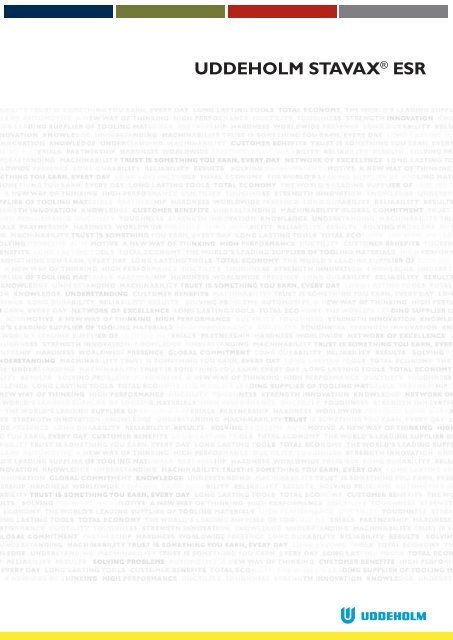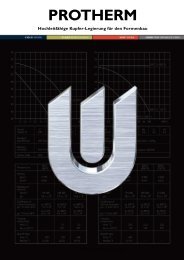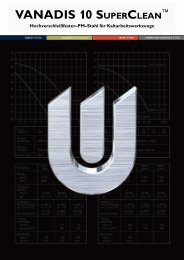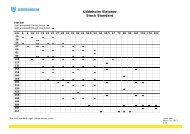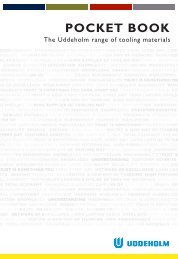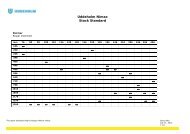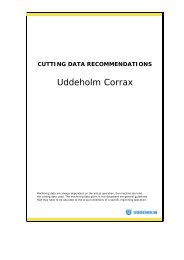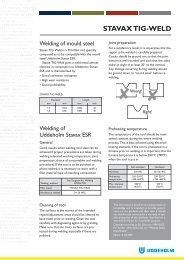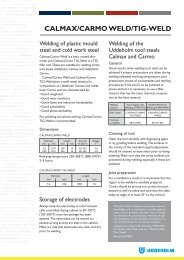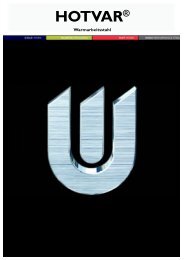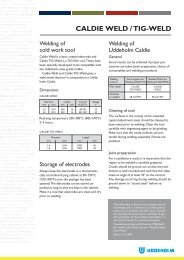UDDEHOLM STAVAX® ESR
UDDEHOLM STAVAX® ESR
UDDEHOLM STAVAX® ESR
You also want an ePaper? Increase the reach of your titles
YUMPU automatically turns print PDFs into web optimized ePapers that Google loves.
<strong>UDDEHOLM</strong> STAVAX ® <strong>ESR</strong>
© <strong>UDDEHOLM</strong>S AB<br />
No part of this publication may be reproduced or transmitted for commercial purposes<br />
without permission of the copyright holder.<br />
This information is based on our present state of knowledge and is intended to provide general<br />
notes on our products and their uses. It should not therefore be construed as a warranty of<br />
specific properties of the products described or a warranty for fitness for a particular purpose.<br />
Classified according to EU Directive 1999/45/EC<br />
For further information see our “Material Safety Data Sheets”.<br />
Edition 11, 05.2013<br />
The latest revised edition of this brochure is the English version,<br />
which is always published on our web site www.uddeholm.com<br />
SS-EN ISO 9001<br />
SS-EN ISO 14001
<strong>UDDEHOLM</strong> STAVAX <strong>ESR</strong><br />
<strong>UDDEHOLM</strong> STAVAX <strong>ESR</strong><br />
Uddeholm Stavax <strong>ESR</strong> is a premium stainless mould steel for small and<br />
medium inserts and cores. Uddeholm Stavax <strong>ESR</strong> combines corrosion and<br />
wear resistance with excellent polishability, good machinability and stability<br />
in hardening.<br />
Mould maintenance requirement is reduced by assuring that core and cavity<br />
surfaces retain their original finish over extended operating periods. When<br />
compared with non stainless mould steel, Uddeholm Stavax <strong>ESR</strong> offers<br />
lower production costs by maintaining rust free cooling channels, assuring<br />
consistent cooling and cycle time.<br />
This classic stainless tool steel is the right choice when rust in production<br />
is unacceptable and where requirements for good hygiene are high, as<br />
within the medical industry, optical industry and for other high quality<br />
transparent parts.<br />
Uddeholm Stavax <strong>ESR</strong> is a part of the Uddeholm Stainless Concept<br />
3
<strong>UDDEHOLM</strong> STAVAX <strong>ESR</strong><br />
General<br />
Uddeholm Stavax <strong>ESR</strong> is a premium grade<br />
stainless tool steel with the following properties:<br />
•good corrosion resistance<br />
•excellent polishability<br />
•good wear resistance<br />
•good machinability<br />
•good stability in hardening<br />
The combination of these properties gives a<br />
steel with outstanding production performance.<br />
The practical benefits of good corrosion<br />
resistance in a plastics mould can be<br />
summarized as follows:<br />
• Lower mould maintenance costs<br />
The surface of cavity impressions retain their<br />
original finish over extended running periods.<br />
Moulds stored or operated in humid conditions<br />
require no special protection.<br />
• Lower production costs<br />
Since water cooling channels are unaffected<br />
by corrosion (unlike conventional mould<br />
steel), heat transfer characteristics, and<br />
therefore cooling efficiency, are constant<br />
throughout the mould life, ensuring consistent<br />
cycle times.<br />
These benefits, coupled with the high wear<br />
resistance of Uddeholm Stavax <strong>ESR</strong>, offer the<br />
moulder low-maintenance, long-life moulds for<br />
the greatest overall moulding economy.<br />
Note: Uddeholm Stavax <strong>ESR</strong> is produced using<br />
the Electro-Slag-Refining (<strong>ESR</strong>) technique,<br />
resulting in a very low inclusion content.<br />
Applications<br />
Uddeholm Stavax <strong>ESR</strong> is recommended for all<br />
types of moulding tools and its special properties<br />
make it particularly suitable for moulds<br />
with the following demands:<br />
• Corrosion/staining resistance, i.e. for<br />
moulding of corrosive materials, e.g. PVC,<br />
acetates, and for moulds subjected to humid<br />
working/storage conditions.<br />
•Wear resistance, i.e. for moulding abrasive/<br />
filled materials, including injection-moulded<br />
thermosetting grades. Uddeholm Stavax <strong>ESR</strong><br />
is recommended for moulds with long<br />
production runs, e.g. disposable cutlery and<br />
containers.<br />
•High surface finish, i.e. for the production<br />
of optical parts, such as camera and sunglasses<br />
lenses, and for medical containers, e.g.<br />
syringes, analysis phials.<br />
Type of mould<br />
Recommended<br />
hardness HRC<br />
Injection mould for:<br />
– thermoplastic materials 45–52<br />
– thermosetting materials 45–52<br />
Compression/transfer moulds 45–52<br />
Blow moulds for PVC, PET, etc. 45–52<br />
Extrusion, pultrusion dies 45–52<br />
Typical C Si Mn Cr V<br />
analysis % 0.38 0.9 0.5 13.6 0.3<br />
Standard<br />
specification<br />
Delivery<br />
condition<br />
Colour<br />
code<br />
AISI 420 modified<br />
Soft annealed to approx. 190 HB.<br />
Black/Orange<br />
Uddeholm Stavax <strong>ESR</strong> core to make<br />
disposable polystyrene beakers. Millions of<br />
close tolerance mouldings with a very high<br />
surface finish have been produced.<br />
4
<strong>UDDEHOLM</strong> STAVAX <strong>ESR</strong><br />
Properties<br />
Physical data<br />
Hardened and tempered to 50 HRC. Data at<br />
room and elevated temperatures.<br />
20°C 200°C 400°C<br />
Temperature (68°F) (390°F) (750°F)<br />
Density, kg/m 3 7 800 7 750 7 700<br />
lbs/in 3 0.282 0.280 0.277<br />
Modulus of elasticity<br />
N/mm 2 200 000 190 000 180 000<br />
tsi 12 900 12 300 11 600<br />
psi 29.0 x 10 6 27.6 x 10 6 26.1 x 10 6<br />
Coefficient of thermal<br />
expansion<br />
/°C from 20°C – 11.0 x 10 -6 11.4 x 10 -6<br />
/°F from 68°F – 6.1 x 10 -6 6.3 x 10 -6<br />
Thermal<br />
conductivity*<br />
W/m °C 16 20 24<br />
Btu in/(ft 2 h °F) 110 138 166<br />
Specific heat<br />
J/kg °C 460 – –<br />
Btu/lb, °F 0.110 – –<br />
*Thermal conductivity is very difficult to measure.<br />
The scatter can be as high as ±15%.<br />
Tensile strength at room<br />
temperature<br />
The tensile strength values are to be considered<br />
as approximate only. All samples were<br />
taken from a bar (in the rolling direction)<br />
25 mm (1") diameter. Hardened in oil from<br />
1025 ±10°C (1880 ±20°F) and tempered twice<br />
to the hardness indicated.<br />
Hardness 50 HRC 45 HRC<br />
Tensile strength R m<br />
N/mm 2 1 780 1 420<br />
kp/mm 2 180 145<br />
psi 258 000 206 000<br />
Yield point R p0,2<br />
N/mm 2 1 360 1 280<br />
kp/mm 2 150 130<br />
psi 197 000 186 000<br />
Corrosion resistance<br />
Uddeholm Stavax <strong>ESR</strong> is resistant to corrosive<br />
attack by water, water vapour, weak organic<br />
acids, dilute solutions of nitrates, carbonates<br />
and other salts.<br />
A tool made from Uddeholm Stavax <strong>ESR</strong> will<br />
have good resistance to rusting and staining<br />
due to humid working and storage conditions<br />
and when moulding corrosive plastics under<br />
normal production conditions.<br />
Note: Special protectants are not recommended<br />
during mould storage. Many protectants<br />
are chloride based and may attack the<br />
passive oxide film, resulting in pitting corrosion.<br />
Tools should be thoroughly cleaned and dried<br />
prior to storage.<br />
Uddeholm Stavax <strong>ESR</strong> shows the best<br />
corrosion resistance when tempered at low<br />
temperature and polished to a mirror finish.<br />
THE INFLUENCE OF TEMPERING TEMPERATURE<br />
ON CORROSION RESISTANCE<br />
Increasing corrosion resistance<br />
Corrosion<br />
resistance<br />
100 200 300 400 500 600°C<br />
210 390 570 750 930 1110°F<br />
Tempering temperature<br />
Heat Treatment<br />
Soft annealing<br />
Protect the steel and heat through to 890°C<br />
(1630°F). Then cool in the furnace at 20°C<br />
(40°F) per hour to 850°C (1560°F), then at<br />
10°C (20°F) per hour to 700°C (1290°F), then<br />
freely in air.<br />
Stress-relieving<br />
After rough machining the tool should be<br />
heated through to 650°C (1200°F), holding<br />
time 2 hours. Cool slowly to 500°C (930°F),<br />
then freely in air.<br />
Hardening<br />
Preheating temperature: 600–850°C (1110–<br />
1560°F).<br />
Austenitizing temperature: 1000–1050°C (1830–<br />
1920°F), but usually 1020–1030°C (1870–<br />
1885°F).<br />
Temperature Soaking time* Hardness before<br />
°C °F minutes tempering<br />
1020 1870 30 56±2 HRC<br />
1050 1920 30 57±2 HRC<br />
* Soaking time = time at hardening temperature after the tool<br />
is fully heated through<br />
Protect the part against decarburization and<br />
oxidation during hardening.<br />
5
<strong>UDDEHOLM</strong> STAVAX <strong>ESR</strong><br />
CCT-GRAPH<br />
Austenitizing temperature 1030°C (1890°F). Holding time 30 minutes.<br />
°F °C<br />
2000 1100<br />
1800<br />
1000<br />
A C 1f = 980°C (1800°F)<br />
1600<br />
1400<br />
1200<br />
1000<br />
800<br />
600<br />
400<br />
200<br />
900<br />
800<br />
700<br />
600<br />
500<br />
400<br />
300<br />
200<br />
100<br />
Martensite<br />
Carbures<br />
Ms<br />
Pearlite<br />
1 2 3 4 5 6 7 8<br />
1 10 100 1 000 10 000 100 000 Seconds<br />
Mf<br />
A C1s = 860°C (1580°F)<br />
Cooling<br />
curve Hardness T 800–500<br />
No. HV10 sec.<br />
1 649 1<br />
2 634 31<br />
3 613 105<br />
4 592 316<br />
5 585 526<br />
6 421 1052<br />
7 274 2101<br />
8 206 4204<br />
1 10 100 1 000 Minutes<br />
1 10 100 Hours<br />
Air cooling<br />
0,2 1,5 10 90 600 of bars, Ø mm<br />
TTT-GRAPH<br />
Austenitizing temperature 1030°C (1890°F). Holding time 30 minutes.<br />
°F °C<br />
2000 1100<br />
1800<br />
1000<br />
A C1f = 980°C (1800°F)<br />
1600<br />
1400<br />
1200<br />
1000<br />
800<br />
600<br />
400<br />
200<br />
900<br />
800<br />
700<br />
600<br />
500<br />
400<br />
300<br />
200<br />
100<br />
Martensite<br />
Bainite<br />
Pearlite<br />
1 10 100 1 000 10 000 100 000 Seconds<br />
A C 1s = 860°C (1580°F)<br />
Temp. Time Hardness<br />
°C hours HV10<br />
800 16.7 173<br />
750 1.8 199<br />
700 0.5 218<br />
650 2.3 240<br />
600 18.3 268<br />
550 18.0 542<br />
500 15.3 613<br />
350 73.6 649<br />
300 7.9 560<br />
275 0.4 606<br />
250 17.2 536<br />
1 10 100 1 000 Minutes<br />
1 10 100 Hours<br />
6
<strong>UDDEHOLM</strong> STAVAX <strong>ESR</strong><br />
Quenching media<br />
• Fluidized bed or salt bath at 250–550°C<br />
(480–1020°F), then cool in air blast<br />
•Vacuum with sufficient positive pressure<br />
• High speed gas/circulating atmosphere<br />
In order to obtain optimum properties, the<br />
cooling rate should be as fast as is concomitant<br />
with acceptable distortion. When heat treating<br />
in a vacuum furnace, a 4–5 bar overpressure is<br />
recommended. Temper immediately when the<br />
tool reaches 50–70°C (120–160°F).<br />
HARDNESS, GRAIN SIZE AND<br />
RETAINED AUSTENITE AS A FUNCTION OF<br />
THE AUSTENITIZING TEMPERATURE<br />
Grain<br />
size<br />
ASTM<br />
10 60<br />
9 58<br />
8<br />
7<br />
6<br />
5<br />
4<br />
3<br />
2<br />
1<br />
56<br />
54<br />
52<br />
50<br />
48<br />
46<br />
44<br />
42<br />
40<br />
Hardness HRC<br />
Tempering<br />
960 980 1000 1020 1040 1060 1080 °C<br />
1760 1795 1830 1870 1905 1940 1975 °F<br />
Austenitizing temperature<br />
Choose the tempering temperature according<br />
to the hardness required by reference to the<br />
tempering graph. Temper twice with intermediate<br />
cooling to room temperature.<br />
TEMPERING GRAPH<br />
Hardness<br />
HRC<br />
60<br />
Austenitizing temp.<br />
55<br />
50<br />
45<br />
40<br />
35<br />
30<br />
25<br />
Holding time<br />
60 min.<br />
Holding time<br />
20 min.<br />
1020°C<br />
Retained<br />
austenite<br />
1030°C<br />
Retained<br />
austenite<br />
100 200 300 400 500 600°C<br />
210 390 570 750 930 1110°F<br />
Tempering temperature<br />
Retained austenite %<br />
40<br />
30<br />
20<br />
10<br />
Retained austenite %<br />
14<br />
1050°C<br />
12<br />
10<br />
8<br />
6<br />
4<br />
2<br />
The tempering curves are obtained after heat treatment<br />
of samples with a size of 15 x 15 x 40 mm,<br />
cooling in forced air. Lower hardness can be expected<br />
after heat treatment of tools and dies due to factors<br />
like actual tool size and heat treatment parameters.<br />
Lowest tempering temperature 250°C (480°F).<br />
Holding time at temperature minimum<br />
2 hours.<br />
Note that:<br />
• tempering at 250°C (480°F) is recommended<br />
for the best combination of toughness,<br />
hardness and corrosion resistance<br />
• the curves are valid for small samples,<br />
achieved hardness depends on mould size<br />
• a combination of high austenitizing temperature<br />
and low tempering temperature<br />
<strong>UDDEHOLM</strong> STAVAX <strong>ESR</strong><br />
DURING HARDENING<br />
An example of dimensional changes on a plate,<br />
hardened under ideal conditions 100 x 100 x<br />
25 mm (4” x 4” x 1”) is shown below.<br />
8<br />
Hardening from Width Length Thickness<br />
1020°C (1870°F) % % %<br />
Martempered Min. +0.02 ±0 -0.04<br />
Max. -0.03 +0.03 –<br />
Air hardened Min. -0.02 ±0 ±0<br />
Max. +0.02 -0.03 –<br />
Vacuum hardened Min. +0.01 ±0 -0.04<br />
Max. -0.02 +0.01 –<br />
Note: Dimensional changes during hardening<br />
and tempering should be added together.<br />
Machining<br />
recommendations<br />
The cutting data below are to be considered<br />
as guiding values which must be adapted to<br />
existing local conditions. More information can<br />
be found in the Uddeholm publication “Cutting<br />
data recommendations”.<br />
Turning<br />
Turning with carbide Turning with<br />
high speed<br />
Cutting data Rough Fine steel<br />
parameter turning turning Fine turning<br />
Cutting<br />
speed (v c )<br />
m/min. 160–210 210–260 18–23<br />
f.p.m. 525–690 690–850 60–75<br />
Feed (f)<br />
mm/r 0.2–0.4 0.05–0.2 0.05–0.3<br />
i.p.r. 0.008–0.016 0.002–0.008 0.002–0.01<br />
Depth of cut<br />
(ap)<br />
mm 2–4 0.5–2 0.5–3<br />
inch 0.08–0.16 0.02–0.08 0.02–0.1<br />
Carbide<br />
designation<br />
ISO P20–P30 P10 –<br />
Drilling<br />
Coated<br />
carbide<br />
Coated<br />
carbide or<br />
cermet<br />
HIGH SPEED STEEL TWIST DRILLS<br />
Drill diameter Cutting speed (v c ) Feed (f)<br />
mm inch m/min f.p.m. mm/r i.p.r.<br />
–5 –3/16 12–14* 40–47* 0.05–0.10 0.002–0.004<br />
5–10 3/16–3/8 12–14* 40–47* 0.10–0.20 0.004–0.008<br />
10–15 3/8–5/8 12–14* 40–47* 0.20–0.30 0.008–0.012<br />
15–20 5/8–3/4 12–14* 40–47* 0.30–0.35 0.012–0.014<br />
* For coated HSS drill v c = 20–22 m/min. (65–70 f.p.m.)<br />
CARBIDE DRILL<br />
Type of drill<br />
Cutting data Indexable Solid Carbide<br />
parameter insert carbide tip 1)<br />
Cutting<br />
speed, (v c )<br />
m/min 210–230 80–100 70–80<br />
f.p.m. 690–755 265–330 230–265<br />
Feed, (f)<br />
mm/r 0.05–0.15 2) 0.08–0.20 3) 0.15–0.25 4)<br />
i.p.r. 0.002–0.006 2) 0.003–0.008 3) 0.006–0.01 4)<br />
1)<br />
Drill with replaceable or brazed carbide tip<br />
2)<br />
Feed rate for drill diameter 20–40 mm (0.8”–1.6”)<br />
3)<br />
Feed rate for drill diameter 5–20 mm (0.2”–0.8”)<br />
4)<br />
Feed rate for drill diameter 10–20 mm (0.4”–0.8”)<br />
Milling<br />
FACE AND SQUARE SHOULDER FACE MILLING<br />
Milling with carbide<br />
Cutting data<br />
parameter Rough milling Fine milling<br />
Cutting speed (v c )<br />
m/min. 180–260 260–300<br />
f.p.m. 600–865 865–985<br />
Feed (f z )<br />
mm/tooth 0.2–0.4 0.1–0.2<br />
inch/tooth 0.008–0.016 0.004–0.008<br />
Depth of cut (a p )<br />
mm 2–4 0.5–2<br />
inch 0.08–0.16 0.02–0.08<br />
Carbide designation P20–P40 P10–P20<br />
ISO Coated Coated carbide<br />
carbide or cermet<br />
END MILLING<br />
Type of end mill<br />
Carbide<br />
Cutting data Solid indexable High speed<br />
parameter carbide insert steel<br />
Cutting<br />
speed (v c )<br />
m/min. 120–150 170–230 25–30 1)<br />
f.p.m. 390–500 560–755 85–100 1)<br />
Feed (f z )<br />
mm/tooth 0.01–0.2 2) 0.06–0.2 2) 0.01–0.30 2)<br />
inch/tooth 0.0004–0.008 2) 0.002–0.008 2) 0.0004–0.01 2)<br />
Carbide<br />
designation<br />
ISO – P20–P30 –<br />
1)<br />
For coated HSS end mill v c = 45–50 m/min. (150–165 f.p.m.)<br />
2)<br />
Depending on radial depth of cut and cutter diameter
<strong>UDDEHOLM</strong> STAVAX <strong>ESR</strong><br />
Grinding<br />
A general grinding wheel recommendation is<br />
given below. More information can be found in<br />
the Uddeholm publication “Grinding of Tool<br />
Steel”.<br />
Wheel recommendation<br />
Soft annealed Hardened<br />
Type of grinding condition condition<br />
Face grinding<br />
straight wheel A 46 HV A 46 HV<br />
Face grinding<br />
segments A 24 GV A 36 GV<br />
Cylindrical grinding A 46 LV A 60 KV<br />
Internal grinding A 46 JV A 60 IV<br />
Profile grinding A 100 LV A 120 KV<br />
Welding<br />
Good results when welding tool steel can be<br />
achieved if proper precautions are taken to<br />
elevated working temperature, joint preparation,<br />
choice of consumables and welding<br />
procedure.<br />
For best result after polishing and photoetching<br />
use consumables with the same composition<br />
as in the mould.<br />
Welding method<br />
Working temperature<br />
Welding<br />
consumables<br />
Hardness after welding<br />
Heat treatment after welding:<br />
Hardened condition<br />
Soft annealed<br />
condition<br />
TIG<br />
200–250°C<br />
STAVAX TIG-WELD<br />
54–56 HRC<br />
Temper at 10–20°C (50–70°F)<br />
below the original tempering<br />
temperature.<br />
Heat through to 890°C (1630°F)<br />
in protected atmosphere. Then<br />
cool in the furnace at 20°C (40°F)<br />
per hour to 850°C (1560°F), then<br />
at 10°C (20°F) per hour to 700°C<br />
(1290°F), then freely in air.<br />
Photo-etching<br />
Uddeholm Stavax <strong>ESR</strong> has a very low content<br />
of slag inclusions, making it suitable for photoetching.<br />
The special photo-etching process that<br />
might be necessary because of Uddeholm<br />
Stavax <strong>ESR</strong>’s good corrosion resistance is<br />
familiar to all the leading photo-etching companies.<br />
Further information is given in the<br />
Uddeholm publication “Photo-etching of tool<br />
steel”.<br />
Polishing<br />
Uddeholm Stavax <strong>ESR</strong> has a very good polishability<br />
in the hardened and tempered condition.<br />
A slightly different technique, in comparison<br />
with other Uddeholm mould steel, should<br />
be used. The main principle is to use smaller<br />
steps at the fine-grinding/polishing stages and<br />
not to start polishing on too rough a surface. It<br />
is also important to stop the polishing operation<br />
immediately the last scratch from the<br />
former grain size has been removed.<br />
More detailed information on polishing<br />
techniques is given in the brochure “Polishing<br />
of Tool Steel”.<br />
Further information<br />
Please contact your local Uddeholm office for<br />
further information on the selection, heat<br />
treatment and application of Uddeholm tool<br />
steel, including the publication “Steel for<br />
Moulds”.<br />
Further information is given in the Uddeholm<br />
brochure “Welding of Tool Steel”.<br />
LASER WELDING<br />
For laser welding Uddeholm Stavax laser weld<br />
rods are available. See Uddeholm information<br />
leaflet “Uddeholm Laser Welding Rods”.<br />
Further information is given in the Uddeholm<br />
brochure “Welding of Tool Steel” or nearest<br />
Uddeholm sales office.<br />
Mould in Uddeholm Stavax <strong>ESR</strong> for producing clear<br />
plastic bowls.<br />
9
<strong>UDDEHOLM</strong> STAVAX <strong>ESR</strong><br />
ELECTRIC ARC<br />
FURNACE<br />
<strong>ESR</strong>-PLANT<br />
UPHILL CASTING<br />
HEAT<br />
TREATMENT<br />
ROLLING MILL<br />
FORGING<br />
MACHINING<br />
STOCK<br />
The <strong>ESR</strong> Tool Steel Process<br />
The starting material for our tool steel is carefully<br />
selected from high quality recyclable steel. Together with<br />
ferroalloys and slag formers, the recyclable steel is melted<br />
in an electric arc furnace. The molten steel is then tapped<br />
into a ladle.<br />
The de-slagging unit removes oxygen-rich slag and<br />
after the de-oxidation, alloying and heating of the steel<br />
bath are carried out in the ladle furnace. Vacuum degassing<br />
removes elements such as hydrogen, nitrogen and<br />
sulphur.<br />
<strong>ESR</strong> PLANT<br />
In uphill casting the prepared moulds are filled with a<br />
controlled flow of molten steel from the ladle.<br />
From this, the steel can go directly to our rolling mill<br />
or to the forging press, but also to our <strong>ESR</strong> furnace<br />
where our most sophisticated steel grades are melted<br />
once again in an electro slag remelting process. This is<br />
done by melting a consumable electrode immersed in an<br />
overheated slag bath. Controlled solidification in the steel<br />
bath results in an ingot of high homogeneity, thereby<br />
removing macro segregation. Melting under a protective<br />
atmosphere gives an even better steel cleanliness.<br />
HOT WORKING<br />
From the <strong>ESR</strong> plant, the steel goes to the rolling mill or<br />
to our forging press to be formed into round or flat bars.<br />
Prior to delivery all of the different bar materials are<br />
subjected to a heat treatment operation, either as soft<br />
annealing or hardening and tempering. These operations<br />
provide the steel with the right balance between hardness<br />
and toughness.<br />
MACHINING<br />
Before the material is finished and put into stock, we also<br />
rough machine the bar profiles to required size and exact<br />
tolerances. In the lathe machining of large dimensions, the<br />
steel bar rotates against a stationary cutting tool. In<br />
peeling of smaller dimensions, the cutting tools revolve<br />
around the bar.<br />
To safeguard our quality and guarantee the integrity of<br />
the tool steel we perform both surface- and ultrasonic<br />
inspections on all bars. We then remove the bar ends and<br />
any defects found during the inspection.<br />
10
Network of excellence<br />
<strong>UDDEHOLM</strong> is present on every continent. This ensures you<br />
high-quality Swedish tool steel and local support wherever you<br />
are. ASSAB is our exclusive sales channel, representing Uddeholm<br />
in the Asia Pacific area. Together we secure our position<br />
as the world’s leading supplier of tooling materials.<br />
www.assab.com<br />
www.uddeholm.com
<strong>UDDEHOLM</strong> 130502.200 / STROKIRK KNAPPEN 201305<br />
<strong>UDDEHOLM</strong> is the world’s leading supplier of tooling materials. This<br />
is a position we have reached by improving our customers’ everyday<br />
business. Long tradition combined with research and product development<br />
equips Uddeholm to solve any tooling problem that may arise.<br />
It is a challenging process, but the goal is clear – to be your number one<br />
partner and tool steel provider.<br />
Our presence on every continent guarantees you the same high quality<br />
wherever you are. ASSAB is our exclusive sales channel, representing<br />
Uddeholm in the Asia Pacific area. Together we secure our position as<br />
the world’s leading supplier of tooling materials. We act worldwide, so<br />
there is always an Uddeholm or ASSAB representative close at hand to<br />
give local advice and support. For us it is all a matter of trust – in longterm<br />
partnerships as well as in developing new products. Trust is<br />
something you earn, every day.<br />
For more information, please visit www.uddeholm.com, www.assab.com<br />
or your local website.


